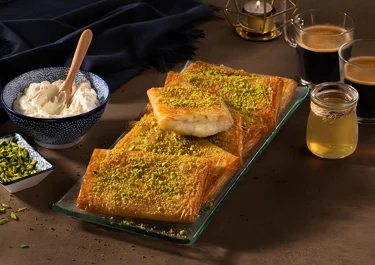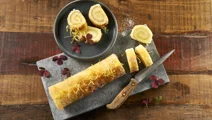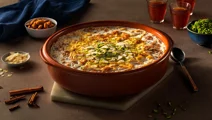Kulaj

Kulaj, or kullaj, is a sweet dessert with fried kulaj dough wrapped around a creamy, sweet filling. Get ready to savour the delightful goodness of crispy kulaj with cream, making for a soft and creamy filling made with whipping cream that is simply irresistible. It is a true treat for your tastebuds, with contrasting flavours and textures that balance each other so wonderfully, and who would not love to dip one of these in a blossom water sugar syrup? These delicious bite-sized treats are great to serve after iftar for kids and adults alike. Enjoy!
Ingredients
|
Whipping cream
|
240 ml |
|---|---|
|
Arla Cravendale Whole milk
|
240 ml |
|
Water
|
240 ml |
|
Starch
|
1 tbsp |
|
Sugar
|
200 g |
|
Semolina
|
170 g |
|
Vanilla powder
|
1 pinch |
|
Kulaj Dough, pre-made
|
300 g |
Sugar syrup
|
Water
|
240 ml |
|---|---|
|
Sugar
|
200 g |
|
Blossom water
|
1 |
Instructions
Tips
Making the perfect kulaj requires attention to detail and a tiny bit of practice. First of all, it is important to brush each dough sheet layer thoroughly with a mixture of water and milk before adding the filling. This helps to create a flaky texture and ensures that the pastry stays together during frying. Do not overfill the pastry, or you will risk the filling leaking out while frying, which can lead to a less crispy exterior. Stick to the recipe, add only 1 tablespoon to each dough sheet, and seal it properly. Be careful not to fry the pastry too long, as this can result in a tough texture. To achieve the perfect crispy texture, fry the kulaj over medium heat until it has a golden-brown hue.
Questions about kullaj
Embark on a culinary adventure and discover the delectable delights of Middle Eastern sweets and pasties with our kullaj dessert recipe. With a bit of practice and patience, you can recreate the sweet treat with a few basic ingredients. Have a look below to learn more about the crispy kullaj pastry.
What is kullaj?
Kullaj is a traditional Middle Eastern sweet and flaky pastry consisting of layers of thin dough filled with a sweet, creamy filling. The pastry is fried and served with sugar syrup. It is a popular dessert that is often enjoyed during special occasions and celebrations like Ramadan. It is a deliciously crisp, flaky pastry with a sweet, creamy centre that is completely irresistible when dipped in blossom water sugar syrup.
How to make kullaj?
First, boil sugar and water and add blossom water to make the syrup. For the filling, boil sugar, water, and milk until the sugar has dissolved. Then, add whipping cream and stir well. Next, stir in semolina and starch until the mixture is cohesive. Cut the kullaj dough into small squares and brush it with milk and water. Place the filling in the centre of each square, fold it over, and fry over medium heat. Finally, place the kullaj on paper towels to drain excess oil. Serve it warm with sugar syrup.
What kind of dough is kullaj dough?
Kullaj is a type of phyllo dough used for making sweet and savoury pastries. It is typically made of sugar, flour, and eggs, but you can often buy it premade and cut it into the desired shape. The kullaj dough is usually fried until golden brown, resulting in a pastry with crisp and flaky layers.
Sweet and traditional kulaj with cream
Discover the world of Middle Eastern sweets and pastries with our kulaj recipe with cream dipped in blossom water sugar syrup. Kulaj is a traditional Middle Eastern dessert that has been around for generations and is enjoyed during special occasions and celebrations. The sweet pastry consists of a thin and flaky pastry dough filled with a creamy and sweet filling. One of the things that make the pastry so popular is the use of simple and natural ingredients, creating a perfect balance of sweet flavours and crispy textures. The final product is often dipped in or served alongside a sweet sugar syrup, adding an extra layer of sweetness to an already delicious dessert.
For more traditional iftar dessert treats and sweets, take a look at our recipes for knafeh with cream, caramel vermicelli garnished with chocolate shavings, and balah al sham with pistachios.
Flaky and crispy kulaj pastry with a creamy filling
One of the key elements of a delicious kulaj is the flaky texture of the pastry. The dough is made by layering thin sheets of pastry and brushing each layer with milk and water, which creates the light and flaky texture that is so desirable in this dessert. The pastry is then filled with a creamy and sweet filling consisting of, among others, semolina and whipping cream, creating a nutty, mild, and creamy kulaj filling. When fried golden brown, the filling in the centre of the dough softens and provides a wonderful contrast to the flaky and crispy exterior of the pastry. Kulaj is such a satisfying dessert that will delight anyone with a sweet tooth.
Delicious bite-sized sweet after-dinner snack
This delicious bite-sized pastry is a staple dessert particularly associated with Ramadan and is often served as a sweet snack or treat after a meal. The contrasting textures in this dessert make for an exciting eating experience that is sure to satisfy the senses. The pastry is further elevated with the addition of sweet and fragrant sugar syrup, made by boiling sugar, water, and blossom water. This enhances the sweetness and flavours of the pastry, making it an even more delectable treat that is guaranteed to bring a smile to your face.
Make it your own
Experiment with the kulaj recipe by adding spices, pistachios, or walnuts to the filling. The addition of crushed nuts and spices like cinnamon or cardamon adds a crunchy texture with a warm, nutty aroma, providing a delightful contrast to the flaky dough. To complement the flavours of the nuts and spices, consider adding a hint of freshly squeezed lemon juice to the sugar syrup. The tartness of the lemon juice adds brightness to the syrup, balancing out the richness of the cream filling and the nutty additions. It makes for a delightful twist on a traditional dessert.








